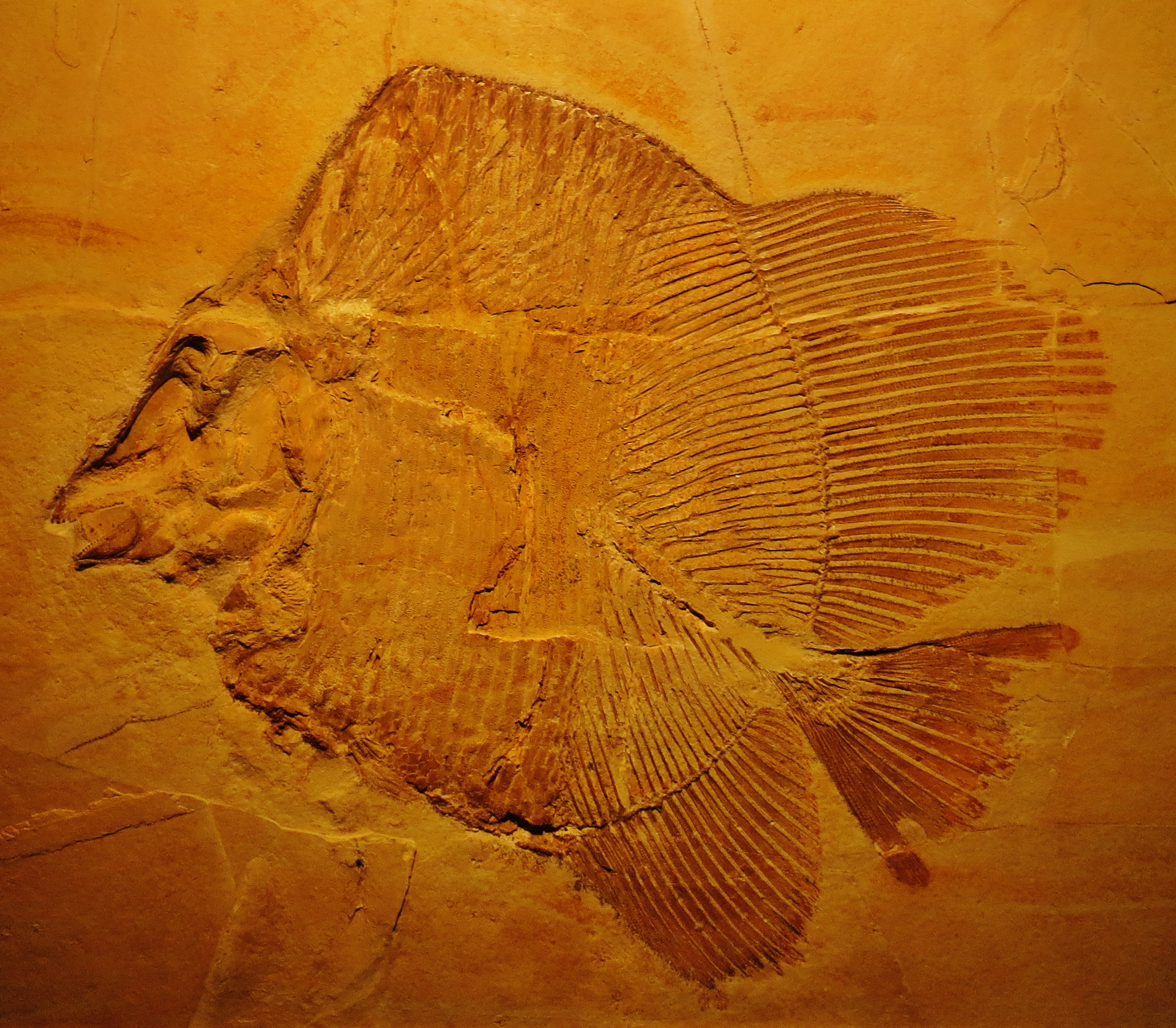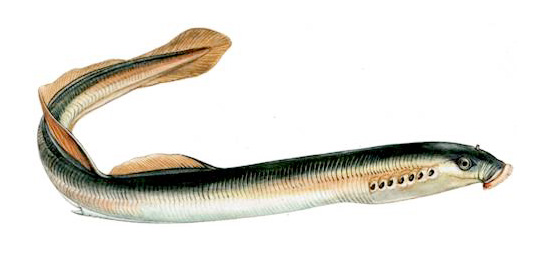|
Pycnodontiformes
Pycnodontiformes is an extinct order of primarily marine bony fish. The group first appeared during the Late Triassic and disappeared during the Eocene. The group has been found in rock formations in Africa, Asia, Europe, North and South America. They were small to middle-sized fish, generally with laterally-compressed deep bodies, some with almost circular outlines, adapted for manuverability in reef-like environments, though the group was morphologically diverse. Most, but not all members of the groups had jaws with round and flattened teeth, well adapted to crush food items (durophagy), such as echinoderms, crustaceans and molluscs. Some pycnodontiformes developed piranha like teeth used for eating flesh. Most species inhabited shallow marine reef environments, while a handful of species lived in freshwater or brackish conditions. While rare during the Triassic and Early-Middle Jurassic, Pycnodontiformes became abundant and diverse during the Late Jurassic, exhibiting a high ... [...More Info...] [...Related Items...] OR: [Wikipedia] [Google] [Baidu] |
Pycnodontidae
Pycnodontidae is an extinct family of ray-finned fishes, ranging from the Jurassic period until the Late Eocene. It was the largest and most derived family of the successful Mesozoic fish order Pycnodontiformes, and one of only two families (alongside the Serrasalmimidae) to survive into the Cenozoic. Genera The following genera are known: * Family Pycnodontidae Agassiz, 1835 ** ''Acrotemnus'' Agassiz, 1843 (=''Macropycnodon'' Shimada ''et al.'', 2010) ** ?''Agassizilia'' Cooper & Martill, 2020 ** ''Akromystax'' Poyato-Ariza & Wenz, 2005 ** ''Anomoeodus'' Forir, 1887 ** ''Apomesodon'' Poyato-Ariza & Wenz, 2002 ** ''Athrodon'' Sauvage, 1880 ** ''Brauccipycnodus'' Taverne & Capasso, 2021 ** ''Coelodus'' Heckel, 1854 ** ''Costapycnodus'' Taverne, Capasso & del Re, 2019 ** ''Gregoriopycnodus'' Taverne, Capasso & del Re, 2020 ** ''Haqelpycnodus'' Taverne & Capasso, 2018 ** ''Iemanja (fish), Iemanja'' Wenz, 1989 ** ''Libanopycnodus'' Taverne & Capasso, 2018 ** ''Macromesodon'' Blake, 19 ... [...More Info...] [...Related Items...] OR: [Wikipedia] [Google] [Baidu] |
Gebrayelichthyidae
Gebrayelichthyidae is a family of extinct pycnodontid fish, with a superficially shrimpfish-like appearance that lived during the lower Cenomanian. The family is composed of two genera, the type genus, '' Gebrayelichthys'', and the monotypic '' Maraldichthys''. The Gebrayelichthyids are highly modified in appearance, having their bodies compressed and vertebrae elongated. Gebrayelichthyidae, together with Gladiopycnodontidae and Coccodontidae, make up the pycnodontid superfamily Coccodontoidea. Description ''Gebrayelichthys'' was strongly flattened on the sides. The body height was 1.8 to 2 times the body length. The head and torso each made up half of the total length. The skull was similar to that of other Pycnodontiformes. The orbit was high up under the curved head profile, the muzzle was long and directed downwards. There were a few pointed teeth on the ploughshare. The anatomy of the lower jaw is unknown due to the lack of evidence. Behind the skull was a tall bo ... [...More Info...] [...Related Items...] OR: [Wikipedia] [Google] [Baidu] |
Sannine Formation
The Sannine Formation, also called the Sannine Limestone, is a Cretaceous geologic formation in Lebanon. It is a Konservat-Lagerstätte that contains a high diversity of well-preserved fish, reptiles, and invertebrates from the Tethys Ocean within its three main localities: Haqel (alternatively Hakel or Haqil), Hjoula (alternatively Hadjoula, Hajoula, or Hgula), and Nammoura (alternatively Namoura). It is one of three major Cretaceous lagerstätte in Lebanon, alongside the older (Barremian-aged) Lebanese amber and the younger (Santonian-aged) Sahel Aalma site. The Sannine Formation localities, combined with Sahel Alma, are together referred to as the "Fish Beds" of Lebanon. Description It is primarily Cenomanian in age, with Haqel and Hjoula being late Cenomanian, while the slightly older Nammoura site is middle Cenomanian. Although Lebanon is now a part of Asia, the depositional environment for both formations would have been located off the coast of northern Africa during ... [...More Info...] [...Related Items...] OR: [Wikipedia] [Google] [Baidu] |
Eomesodon Gibbosus 723
''Eomesodon'' (Greek for "dawn ''Mesodon''", ''Mesodon'' being a now-disused pycnodont genus) is an extinct genus of prehistoric marine pycnodont fish. It contains only a single definitive species, ''E. liassicus'' ( Egerton, 1854) from the Early Jurassic (Hettangian to Sinemurian) of England (Lower Lias), France, and Belgium ( Marnes de Jamoigne Formation). The specimen from England is known from a nearly complete skeleton. ''E. liassicus'' is the only known species of pycnodont known from the earliest Jurassic Europe following the Triassic-Jurassic extinction event, and the group does not see further diversification in Europe until the Toarcian. In addition to ''E. liassicus'', several other disputed species are known from earlier (Late Triassic) and much later (up to the earliest Cretaceous). However, the status of these species and their placement within ''Eomesodon'' is disputed, and later studies refer to them as "''Eomesodon''". If the Triassic species actually did belo ... [...More Info...] [...Related Items...] OR: [Wikipedia] [Google] [Baidu] |
Coccodontidae
Coccodontidae is a family of extinct pycnodontid fish that lived during the lower Cenomanian. The various genera had massive, curved spines. The family is composed of five genera, the type genus, '' Coccodus'', '' Paracoccodus'' which was split off from ''Coccodus'', the newly described '' Corusichthys'', the sexually dimorphic '' Hensodon'', and '' Trewavasia''. '' Ichthyoceros'' was, at one time, placed in Coccodontidae, but then was moved with ''Trewavasia'' in "Trewavasiidae,"Nursall, Ralph Mesozoic Fishes – Systematics and Paleoecology, G. Arratia & G. Viohl (eds.), Verlag Dr. Friedrich Pfeil, München, Germany, 1996 – "The phylogeny of pycnodont fishes" and then, in 2014, was placed in the related pycnodontid family Gladiopycnodontidae, while ''Trewavasia'' was returned to Coccodontidae. Coccodontidae, together with Gladiopycnodontidae and the superficially shrimpfish-like Gebrayelichthyidae, make up the pycnodontid superfamily Coccodontoidea. See also * Prehi ... [...More Info...] [...Related Items...] OR: [Wikipedia] [Google] [Baidu] |
Brembodontidae
''Brembodontidae'' is a Family (biology), family of Pycnodontiformes, Pycnodontiform fish from the Late Triassic (Norian). It contains two Genus, genera from the Calcare di Zorzino in Cene, Italy References {{Taxonbar, from=Q18609758 Pycnodontiformes Late Triassic fish of Europe Fossil taxa described in 1981 Ray-finned fish families ... [...More Info...] [...Related Items...] OR: [Wikipedia] [Google] [Baidu] |
Jurassic
The Jurassic ( ) is a Geological period, geologic period and System (stratigraphy), stratigraphic system that spanned from the end of the Triassic Period million years ago (Mya) to the beginning of the Cretaceous Period, approximately 143.1 Mya. The Jurassic constitutes the second and middle period of the Mesozoic, Mesozoic Era as well as the eighth period of the Phanerozoic, Phanerozoic Eon and is named after the Jura Mountains, where limestone strata from the period were first identified. The start of the Jurassic was marked by the major Triassic–Jurassic extinction event, associated with the eruption of the Central Atlantic magmatic province, Central Atlantic Magmatic Province (CAMP). The beginning of the Toarcian Age started around 183 million years ago and is marked by the Toarcian Oceanic Anoxic Event, a global episode of Anoxic event, oceanic anoxia, ocean acidification, and elevated global temperatures associated with extinctions, likely caused by the eruption of the Kar ... [...More Info...] [...Related Items...] OR: [Wikipedia] [Google] [Baidu] |
Ichthyoceros
''Ichthyoceros spinosus'' is an extinct pycnodontid that lived during the lower Cenomanian of what is now Lebanon. ''I. spinosus'' had a triple, forward-pointing horn-like spine between its eyes, very similar to the single spine of '' Trewavasia'', and a massive, multipointed spine emanating from the back of its head. It was originally placed in the family Coccodontidae, but then was transferred to "Trewavasiidae" with ''Trewavasia''. Recently, it has been placed in Gladiopycnodontidae due to recent anatomical similarities with the various genera within that family, including '' Gladiopycnodus''. See also * Prehistoric fish * List of prehistoric bony fish This list of prehistoric bony fish is an attempt to create a comprehensive listing of all Genus, genera from the fossil record that have ever been considered to be bony fish (class Osteichthyes), excluding purely vernacular terms. The list includ ... * '' Trewavasia'', its close relative References Pycnodontiform ... [...More Info...] [...Related Items...] OR: [Wikipedia] [Google] [Baidu] |
Neopterygii
Neopterygii (from Greek νέος ''neos'' 'new' and πτέρυξ ''pteryx'' 'fin') is a subclass of ray-finned fish (Actinopterygii). Neopterygii includes the Holostei and the Teleostei, of which the latter comprise the vast majority of extant fishes, and over half of all living vertebrate species. While living holosteans include only freshwater taxa, teleosts are diverse in both freshwater and marine environments. Many new species of teleosts are scientifically described each year. The potentially oldest known neopterygian is the putative " semionotiform" '' Acentrophorus varians'' from the Middle Permian of Russia; however, one study incorporating morphological data from fossils and molecular data from nuclear and mitochondrial DNA, places this divergence date at least 284 mya (million years ago), during the Artinskian stage of the Early Permian. Another study suggests an even earlier split (360 myr ago, near the Devonian-Carboniferous boundary). Evolution a ... [...More Info...] [...Related Items...] OR: [Wikipedia] [Google] [Baidu] |
Lagerstätte
A Fossil-Lagerstätte (, from ''Lager'' 'storage, lair' '' Stätte'' 'place'; plural ''Lagerstätten'') is a sedimentary deposit that preserves an exceptionally high amount of palaeontological information. ''Konzentrat-Lagerstätten'' preserve a high concentration of fossils, while ''Konservat-Lagerstätten'' offer exceptional fossil preservation, sometimes including preserved soft tissues. ''Konservat-Lagerstätten'' may have resulted from carcass burial in an anoxic environment with minimal bacteria, thus delaying the decomposition of both gross and fine biological features until long after a durable impression was created in the surrounding matrix. ''Fossil-Lagerstätten'' spans geological time from the Neoproterozoic era to the present. Worldwide, some of the best examples of near-perfect fossilization are the Cambrian Maotianshan shales and Burgess Shale, the Ordovician Soom Shale, the Silurian Waukesha Biota, the Devonian Hunsrück Slates and Gogo Formation, the Ca ... [...More Info...] [...Related Items...] OR: [Wikipedia] [Google] [Baidu] |
Late Triassic
The Late Triassic is the third and final epoch (geology), epoch of the Triassic geologic time scale, Period in the geologic time scale, spanning the time between annum, Ma and Ma (million years ago). It is preceded by the Middle Triassic Epoch and followed by the Early Jurassic Epoch. The corresponding series (stratigraphy), series of rock beds is known as the Upper Triassic. The Late Triassic is divided into the Carnian, Norian and Rhaetian Geologic time scale, ages. Many of the first dinosaurs evolved during the Late Triassic, including ''Plateosaurus'', ''Coelophysis'', ''Herrerasaurus'', and ''Eoraptor''. The Triassic–Jurassic extinction event began during this epoch and is one of the five major mass extinction events of the Earth. Etymology The Triassic was named in 1834 by Friedrich August von Namoh, Friedrich von Alberti, after a succession of three distinct rock layers (Greek meaning 'triad') that are widespread in southern Germany: the lower Buntsandstein (colourful ... [...More Info...] [...Related Items...] OR: [Wikipedia] [Google] [Baidu] |




